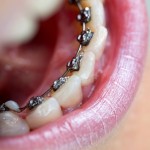
Lingual orthodontic treatments have been available for a number of decade and their improved aesthetic appearance has seen their popularity grow in recent years. Consequently, a number of studies have sought to identify the advantages and disadvantages of lingual orthodontic approaches compared to traditional buccal approaches.
The aim of this review was to assess if there are differences in treatment effects between labial and lingual fixed appliances?
Methods
Searches were conducted in the Pubmed/Medline, Cochrane Library and LILACS databases supplemented by hand searches of the journals, American Journal of Orthodontics and Dentofacial Orthopedics, The Angle Orthodontist, European Journal of Orthodontics and Orthodontics & Craniofacial Research. There were no restrictions in terms of year of publication or language.
Randomised controlled trials (RCTs), prospective controlled trials (CCTs) and retrospective studies comparing changes in the cephalometric values of patients with malocclusions requiring orthodontic treatment where one group were treated with lingual technique and the other group a buccal technique. Two reviewers selected studies and assessed the risk of bias independently using the Cochrane tool or the Newcastle-Ottawa Scale. Meta-analysis was conducted using a random effects model.
Results
- 4 studies (1 RCT, 2 CCTs, 1 retrospective) involving a total of 249 patients were included.
- The RCT was considered to be at high risk of bias.
- 2 of the non-randomised studies were considered to be oh high quality and one of moderate quality.
- 2 studies contributed to a meta-analysis that included six angles and distances. A non-significant tendency was observed in lingual appliances to increase the interincisal angle (95% CI −0.80-8.99; p = 0.101) and reduce the angle between the major axis of upper central incisor and the sellar-nasion plane.
Conclusions
The authors concluded: –
The present systematic review found no statistically significant cephalometric differences between the lingual and labial orthodontic techniques. However, there was a tendency to increase the interincisal angle and reduce the angle between the major axis of the upper central incisor and the sellar-nasion plane. These findings indicate that treatment with lingual appliances favours incisor tip- ping by exerting lingual crown torque. However, because of the small number of included studies, the results of this meta-analysis should be interpreted with caution.
Comments
This review has undertaken a good search of 3 major databases supplemented it by hand searches of specific orthodontic journals and not restricted the publication dates or languages. However, only 4 studies were identified with the only RCT being considered to be at high risk of bias. The meta-analysis included one of the CCTs and the retrospective study involving just 169 patients. This focused on 6 angles and distances finding no significant differences between lingual and buccal approaches. An earlier review conducted by this by this group suggested that more adverse events were seen using a lingual approach (Dental Elf – 21st Jun 2016).
While this review brings together the available studies on this question they are limited in number, size and quality, consequently the findings should be interpreted cautiously.
Links
Primary paper
Fadi Ata-Ali, Teresa Cobo, Felix De Carlos, Juan Cobo and Javier Ata-Ali . Are there differences in treatment effects between labial and lingual fixed orthodontic appliances? A systematic review and meta-analysis. BMC Oral Health (2017) 17:133 DOI 10.1186/s12903-017-0424-z
Other references
Dental Elf – 21st Jun 2016
Dental Elf – 21st Apr 2016
Lingual fixed orthodontic appliances: insufficient evidence of effectiveness
